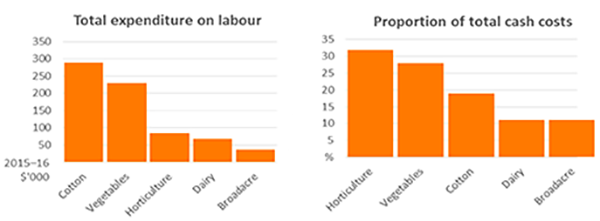Authors: Haydn Valle, Niki Millist, David Galeano
 Figure 1 Total expenditure on labour, by industry, 2014–15 average per farm
Figure 1 Total expenditure on labour, by industry, 2014–15 average per farm
The survey was conducted before the Government brought in changes to the tax rate applied to working holiday makers (the so called ‘backpacker tax’). This survey did not seek to determine farmers’ expected labour force responses or losses from changes to the tax. Instead, it focused on understanding the current farm workforce. The results from this survey could provide a base case for examining changes in the make-up of the labour force in the future.
Key findings
- In general, labour use (measured by total expenditure and wages as a proportion of total cash costs) is greater in the vegetable, horticulture and cotton industries than in other agricultural industries. However, the large distribution in the amount and type of labour used reflects the diversity of farm types captured by these surveys.
- In the vegetable and horticulture industries, most farm employees are seasonal workers and most of these employees are working in Australia on a visa. In contrast, the cotton industry has more full-time employees, and those workers classified as seasonal are generally Australian or New Zealand residents.
- In 2015–16, most farms did not face challenges filling vacancies or recruiting staff.
- Most farmers indicated that they did not intend to change or would make minimal changes to their businesses over the next five years. However, farmers believed they would need to acquire new skills and knowledge to cope with a changing external environment.
- Farmers saw lower farm business profits and the availability and quality of labour as the greatest workforce challenges facing farm businesses over the next five years.
- Some farms identified the backpacker tax as a potential major workforce difficulty. This was of more concern to horticulture farmers (14 per cent) than to vegetable farmers (6 per cent). None of the cotton farms surveyed indicated that the backpacker tax was a likely future issue.
Downloads
ABARES Labour Force Survey 6 - pdf [1.4 MB]
ABARES Labour Force Survey - docx [2.2 MB]
Data – Labour force survey – Tables and Figures - xls [0.1 MB]
